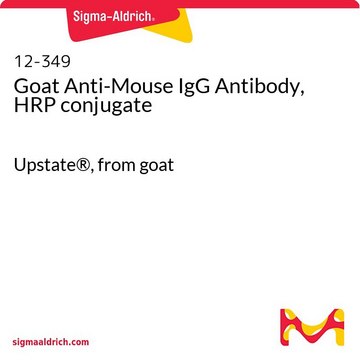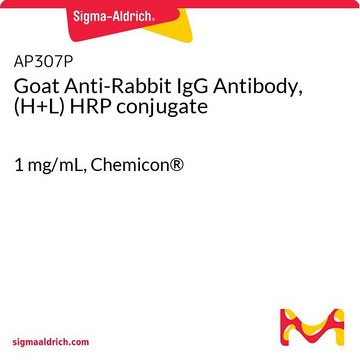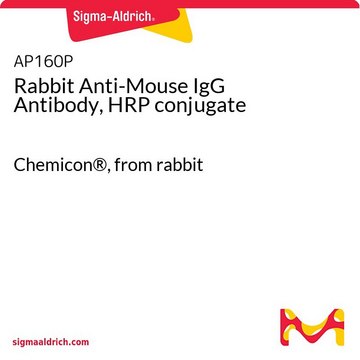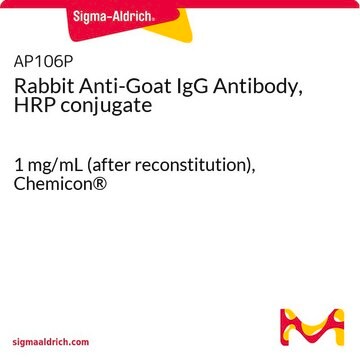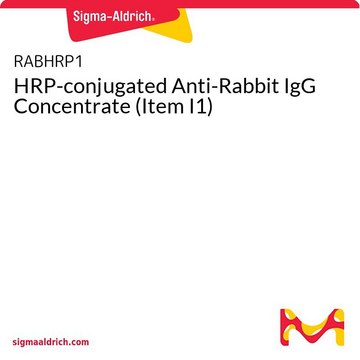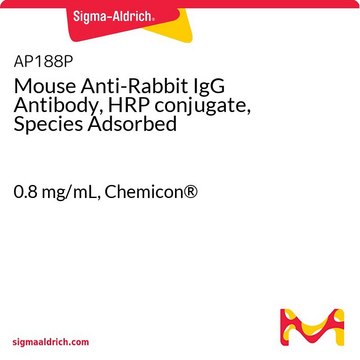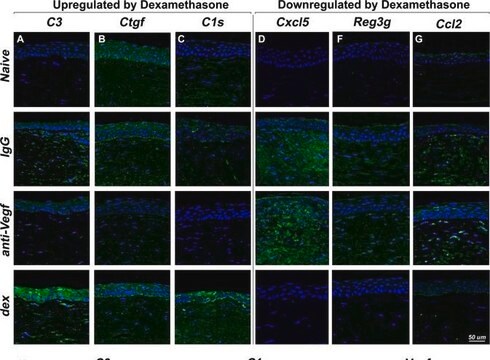AP187P
Goat Anti-Rabbit IgG Antibody, HRP conjugate, Species Adsorbed
0.8 mg/mL, Chemicon®
Synonim(y):
Kozie IgG przeciw królikowi
About This Item
Polecane produkty
pochodzenie biologiczne
goat
Poziom jakości
białko sprzężone
peroxidase conjugate
forma przeciwciała
F(ab′)2 fragment of affinity isolated antibody
rodzaj przeciwciała
secondary antibodies
klon
polyclonal
reaktywność gatunkowa
rabbit
producent / nazwa handlowa
Chemicon®
stężenie
0.8 mg/mL
metody
ELISA: suitable
western blot: suitable
Warunki transportu
wet ice
docelowa modyfikacja potranslacyjna
unmodified
Specyficzność
Zastosowanie
Secondary & Control Antibodies
Secondary Antibodies Adsorbed for Dual Labeling
1:500-1:5,000 for Immunoohistochemistry on tissue sections.
1:5,000-1:100,000 for ELISA and Western blotting with chromogenic substrates.
1:10,000-1:200,000 for western blotting with chemiluminescent substrates.
Optimal working dilutions must be determined by the end user.
Postać fizyczna
RECONSTITUTION:
Reconstitute with 1.5 mL sterile distilled water.
Przechowywanie i stabilność
Informacje prawne
Oświadczenie o zrzeczeniu się odpowiedzialności
Nie możesz znaleźć właściwego produktu?
Wypróbuj nasz Narzędzie selektora produktów.
Hasło ostrzegawcze
Warning
Zwroty wskazujące rodzaj zagrożenia
Zwroty wskazujące środki ostrożności
Klasyfikacja zagrożeń
Eye Irrit. 2 - Skin Irrit. 2
Kod klasy składowania
11 - Combustible Solids
Klasa zagrożenia wodnego (WGK)
WGK 3
Temperatura zapłonu (°F)
Not applicable
Temperatura zapłonu (°C)
Not applicable
Certyfikaty analizy (CoA)
Poszukaj Certyfikaty analizy (CoA), wpisując numer partii/serii produktów. Numery serii i partii można znaleźć na etykiecie produktu po słowach „seria” lub „partia”.
Masz już ten produkt?
Dokumenty związane z niedawno zakupionymi produktami zostały zamieszczone w Bibliotece dokumentów.
Klienci oglądali również te produkty
Nasz zespół naukowców ma doświadczenie we wszystkich obszarach badań, w tym w naukach przyrodniczych, materiałoznawstwie, syntezie chemicznej, chromatografii, analityce i wielu innych dziedzinach.
Skontaktuj się z zespołem ds. pomocy technicznej

